Easy Wild Turkey Tacos Recipe
May 7th, 2017 by BTC Editor
Of all the game meats, wild turkey is by far my favorite. I love making wild turkey nuggets—small chunks rolled in egg and covered in Italian breadcrumbs, then fried. Yum! But lately, I’ve been looking for new, healthier ways to cook my turkey harvest. I decided to try making crockpot turkey tacos. Good decision, because they were delicious…and super easy!
What you need:
- 1-1/2 lbs. wild turkey breast meat
- 1 tbsp. chili powder
- 1/2 tsp. paprika
- 1-1/2 tsp. ground cumin
- 1/4 tsp. onion powder
- 1 tsp. minced garlic (can replace with 1/4 tsp. garlic powder)
- 16 oz. of your favorite salsa
- Optional: 1/2 tsp. hot pepper flakes*
- Optional: 1/2 cup water
*I like spicy food, so I use a mix of dried cayenne and habanero peppers. You can substitute with red pepper flakes, or eliminate for less spice.
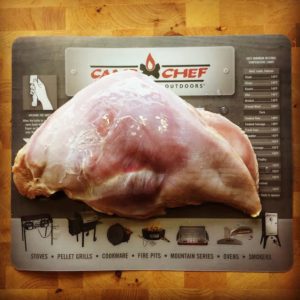
Instructions:
- Place whole chunk of wild turkey breast in crockpot
- Mix all dry ingredients together in small bowl, then sprinkle onto turkey breast
- Pour salsa over turkey; if the salsa is extra chunky, add water
- Cook on low 5-6 hours (or high for 3-4 hours)
- Before serving, use two forks to shred the meat and stir all ingredients together
Serve immediately with desired taco toppings such as shredded cheese, sour cream, avocado or guacamole, lettuce, tomato, hot sauce, rice, corn, etc. There are so many options, and you can personalize it to whatever you prefer.

Ingredients can be adjusted to your personal tastes, or you can also use store-bought taco seasoning in place of the listed dry ingredients (I prefer to make my own to eliminate the salt and preservatives).
Sarah Honadel is an avid outdoors-woman from Kentucky who enjoys hunting turkey, deer and elk. She is a Team Member at Huntress View and Brand Champion for ReelCamo Girl, two organizations that work to support, encourage and empower women in the outdoors. Follow her on Instagram @waddysarah and @arrowridgecreations.
The First Hunt
April 9th, 2017 by BTC Editor
With having accumulated many special memories over the course of my 35 years of hunting, I can vividly remember so many details. Memories begin with my first successful whitetail deer hunt, my first turkey, and my first harvest with a bow. All of these events pale in comparison to being able to watch my eight-year-old son squeeze the trigger on his very first deer…a spike buck.
Like many fathers who love to hunt, my hopes had always been to raise my two children to share my passion for hunting and the beauty of the outdoors. I know many hunters; however, whose children had grown up with little or no interest in following in their father’s footsteps when it came to pursuing wild game. I often wondered what it is that separates those kids who develop the passion and those that do not. There is no sure way of getting or keeping our children involved in hunting, yet there are certain things that we can do to increase the odds of them developing that lifelong passion.
From my experience and from what I have learned from others, it is key to get them involved at an early age. Children generally do take an early interest in their parent’s passion for the outdoors. My children were always there when I would bring home a harvested animal. They would come rushing outside to take a look. Whether it was gutting a deer or processing one, I allowed them to be a part of it. I made sure to answer any of the questions that they may have had. I would always say to them, “One day you both will get to go hunting with dad.”
Once a child reaches the age where you feel it is the right time to take them hunting, you must make necessary changes to how you hunt. You are going to have to keep it somewhat “fun” in their eyes. It could be a tag-along trip where they sit with you or simply head out to do some scouting. Explain what you are doing and what you are looking for. Allow them to utilize some of the gear, such as binoculars or rangefinders. If you are like me, you may need to shorten the time frame of your hunt. For instance, you may be accustomed to a 4 or 5-hour sit, but now you may need to make it only a few hours to prevent the child from becoming bored. Once you detect boredom, either change things up a bit or head to the house.
You may ask yourself, “When is the right time to take your child hunting?” The answer depends on the individual child. I believe it is important to not push them to go until they have shown the desire. We, as hunters, all want our children to share our love for hunting and the outdoors; however, if you force it on them, you risk driving them farther away. If they do not show as much interest as you would like, then simply give them their space. Always keep the invitation open and never force them to be an unwilling participant.
Make sure the child, when the day comes that they are ready, has the correct equipment. Make sure they are comfortable with the proper clothing. Even for seasoned hunters, we know the misery of freezing our butts off while trying to stay out for as long as possible. If it is miserable for us, imagine how much more it will be for the child who is not accustomed to cold temperatures for extended periods of time. You do not want to over-clothe them either. They need to be comfortable with proper fitting clothing. Remember, they so want to be like dad. Make their attire fit the part of a hunter.

And just as important as the clothes they wear, is the weapon that they carry or utilize. Proper fit, whether a bow or a gun, is crucial. For a rifle, that means making sure your child can properly shoulder and aim the firearm and that the recoil is not more than they can handle. Assure they are comfortable with it, via practice, and preach the importance of firearms safety. I made sure to allow my son to carry his unloaded weapon to the stand. He held that rifle so tight and walked with so much pride. If your child is using a bow, it is important to assure proper fit with correct draw length and draw weight. If your child is not comfortable with the weapon they are utilizing, they probably will not be able to shoot it accurately or consistently. This can quickly lead to disappointment and frustration with hunting. If you are truly serious about getting your child involved, it is your duty to equip them properly. Just as you would do for yourself.
Finally, to keep them interested in hunting, sooner or later, they are going to have to experience the taste of success. While you and I may be able to sit in a tree stand or blind for hours on end, day after day and never draw back an arrow or push that safety forward, a young child is going to likely deem this boring and lose interest. This may mean that you need to start them out on smaller game or, in my case, place them in a situation where you know they will have a high chance at success in harvesting their first game. Sure, I dreamed of my son taking a nice big buck on his first hunt, but I was just as thrilled when a couple of spikes came in and presented him a shot. After my son dropped the deer in his tracks, I think it is safe to say, he was hooked. He experienced the “rush” that all of us, as hunters, have felt. Now, he does not mind spending a little more time waiting for the next opportunity.
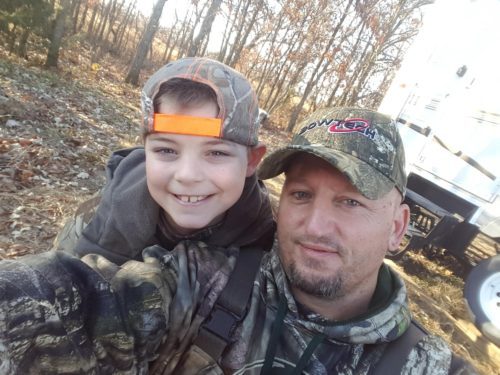
When that special day came for just the two of us to make that trip to the field, I felt confident that we had put in the time preparing for a successful hunt. I am testifying that there is nothing more rewarding than watching your child harvest his or her first game animal. The excitement in their eyes, and to feel the pride of knowing that you played a major part in their success, is a feeling like no other. Most importantly, there is a bond that develops between you and your child that makes it that much more special. A special closeness that could only come from time shared afield. A bond that, if properly nurtured, will last a lifetime.
Blog post originally shared on “The Break TV”.
By Bobby Raybourn
Bobby is a team hunter on “The Break TV” on the Pursuit Channel. He grew up near Odessa, MO and began hunting at a very young age alongside of his father and older brother. Bobby has also taken up Taxidermy in his spare time and his business is thriving.
5 Tips For Bowhunting Turkeys
March 12th, 2017 by BTC Editor
Planning on using your bow to harvest a turkey this spring? If you’ve ever hunted turkeys before then you know it will be no easy task. Hunting turkeys with a shotgun is often enough to drive a hunter crazy, let alone adding the challenge of a stick and string. Successfully harvesting a turkey with your bow is perhaps one of the hardest, yet most rewarding hunts you will ever be a part of.
Browning Trail Cameras Pro Staff members Don and Dan Pickell have been bowhunting for years and make bagging a gobbler with a bow look like a piece of cake.

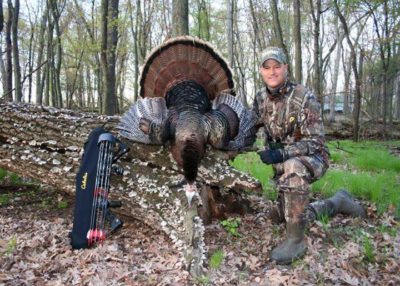
Here are a few of their tips for bowhunting turkeys this spring:
1) Scouting
Spend some time in the woods before season starts so you can be as prepared as possible before opening day. Look for roosting sites, turkey feathers & droppings, feeding areas and travel routes. Once you’ve found some turkey sign or what looks like some good locations, it’s time to hang your trail cameras.
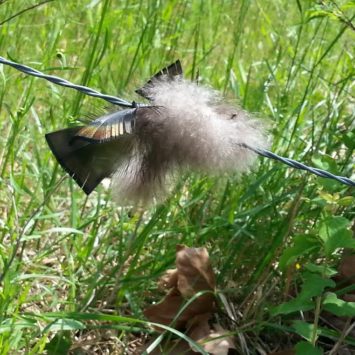
2) Trail Cameras
Get your Browning Trail Cameras out now and keep them out throughout turkey season. Trail cameras will help pinpoint the time of day the turkeys are in certain locations so you know when you should target these specific areas while hunting.
When setting up your cameras, keep the location in mind and set them accordingly. For example, you may want to set your camera on Time Lapse mode while watching large fields or new locations where you aren’t sure where the turkeys are entering or leaving. The camera will take images of the entire field, so you will end up capturing game at 200 + yards away, where a conventional game camera would not normally trigger a picture.
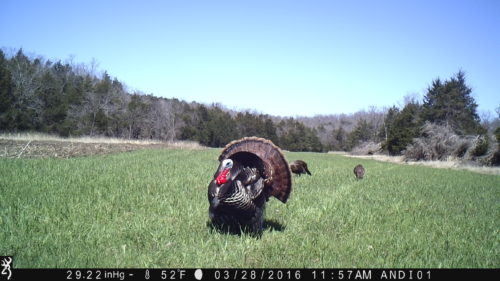
3) Setup
Pattern the birds with your trail cameras and set up your ground blinds accordingly. If they aren’t coming into your call it’s usually best to just sit and wait them out; Remember, you’re hunting with a bow, not a shotgun, so run and gun is a lot more difficult. More often than not, your trail cameras will tell you where you need to be. Remember what you learned about their behavior while studying your trail camera photos and stick with that.
4) Decoys
A decoy will often help bring the birds within bow range while keeping their eyes off of you, but we have also had toms skirt our decoys at times. When this happens we usually pull the decoys and set up in a proven spot where we have them patterned with our Browning Trail Cameras and ambush them. It just depends on the bird’s moods.
5) Shot Placement & Recovery
With a shotgun we aim at the bottom of the neck to allow for the pattern to cover both his head and neck. With a bow, we prefer a broadside shot through the wings if possible so an injured bird can’t fly off, making it harder to recover. Whether we use a bow or a shotgun, as soon as a shot is made we go after the bird and get a foot on its head, just in case.
Going into turkey season, it’s best to have a positive outlook and lots of patience! Turkeys are fickle creatures and even having the “perfect setup” is often not enough to harvest a tom. Make sure you’re as prepared as possible ahead of time by scouting with your trail cameras and keeping the above tips in mind. Harvesting a big longbeard with your bow is worth all of the hassle. Stay safe and have fun this turkey season!
By Andrea Haas

Andrea Haas is a Pro-Staffer from Missouri who enjoys hunting deer, turkeys, and upland birds. She is also the founder of the Huntress View, an organization formed to help strengthen the ever growing community of women hunters.
Hunting With Outfitters
December 26th, 2016 by BTC Editor
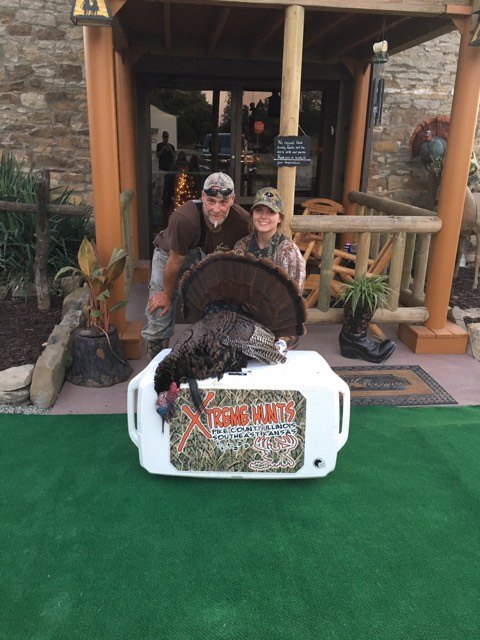
Whether you have hunted with an outfitter before or are considering doing so in the future, here is a list of a few things you, the client, should think about before going. I believe the most important tip I can give you is to always be prepared when booking a hunt with an outfitter, especially if it will be in a different state. With that being said, communication with your outfitter and guide is the key to getting the most out of your hunt.
Come Prepared
- Know what your outfitter will provide based on the type of hunt you booked (i.e. lodging, meals, blinds, stands, fully-guided vs. semi-guided, etc.) Call your outfitter to see if they have any recommendations for what you’ll need to bring.
- On top of bringing the necessary tools to take your game, make sure that your equipment is dialed in. Do this before you leave and again once you arrive just in case something changed while traveling. You expect your guide to give you his or her best work so it’s only fair for you to do the same.
- Know the type of terrain you’ll be hunting so that you can be prepared physically and mentally. If you don’t know this already you can find this out by a quick internet search.
- Know the typical weather conditions so you can bring all the necessary clothing that you may need (i.e. rain gear; rubber, insulated or snake boots, etc.)
Listen to Your Guide & Be Open Minded
- Deer and turkey habits will vary state to state so what you are used to back home may not be what you’ll experience on this hunt. Remember your guide does this every day for a living in that particular area so they know what they’re doing. Trust their instincts with blind/decoy setup and take their advice on how to hunt that animal. A good example is turkey hunting: If your guide says they don’t do “run and gun” type hunting that usually means their hunters are more successful with the blind setups and the client being patient. Listen to that advice or else you’ll probably end up with an unsuccessful hunt.
- Remember that outfitters and guides can only do so much when it comes to animals and their behavior. If your guide did their job, you have listened to their advice and continued to take it then try not to put all the blame on the guide. Animals can be very tricky and can change their behaviors in a second.
Tips for the Hunt
- If you have physical limitations that require a different type of setup, make sure to tell your guide before you arrive so they can plan extra time for setup or can get extra help if needed.
- If you have a specific goal in mind, and it can work with your hunt, make sure to tell your guide so you can get the best overall hunt. Whether it be a trophy to take home, to be able to witness beautiful scenery, anything legal or you’re just looking for a relaxing trip, communicating this to your guide will make your hunting experience better. Remember to be open minded, sometimes trophies aren’t always available, spot and stalks aren’t recommended for certain animals or areas and sometimes the animals just don’t want to cooperate.
- Gun etiquette. This may seem like common sense but you’d be surprised how often people forget the direction their gun barrel is aiming. Not only is bad gun etiquette dangerous, it’s very inconsiderate to your fellow hunters. Whether the gun is loaded or not, always treat it as if it were. This could save a life and also help ease a little tension on the hunt.
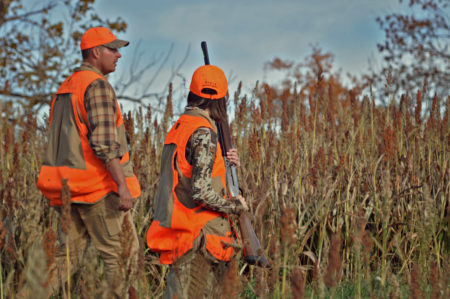
Helping Your Guide
- If you’re able, asking your guide if they need help with decoy setup is very considerate. Most would love to have an extra hand to help set everything out as long as it follows the particular setup they have in mind.
- Most outfitters include cost to cover the cleaning of the animals but it’s always a good question to ask. If the outfitter takes care of this offering to help hold legs, head or wings back for them is always very much appreciated.
- Calling can be different depending on the type of hunt you’re going on and the outfitter. If the outfitter covers the calling but that is something you look forward to then make sure to let them know. A good guide will know when the clients’ calling won’t hurt the hunt.
- After you’ve taken your animal it’s time to get the perfect photo. Your guide will know how to get that beautiful photo of your harvest but if you have a particular pose or tradition in mind just let them know.
Camp/Lodge Manager
- Camp managers are used to cooking for a lot of people so usually that comes with a large mess. Just because you are away from home doesn’t mean it’s okay to leave more of a mess than necessary. Be considerate and try and pick up after yourself to show your respect for the outfitter and yourself. If you’d like to offer more than that I’m sure they would greatly appreciate it. They usually have the cooking part down but offering to help with dishes or setting the table can be a big help.
- Make sure to let them know ahead of time if you have any special dietary needs or allergies as this will help them with meal preparation.
Tipping
- Although it’s not really talked about tipping is very important to guides and how they make their living. Just like a waitress or any type of service business you deal with, you usually expect to leave a tip if you believe they did a good job. If you believe your guide did a good job then a good base percentage to tip is about ten percent. If you think they did a great job than show it with a great tip.
- Don’t forget your camp manager when it comes to tipping. If you believe they have done a good job then show them with a tip as well. Camp managers usually don’t get paid anything near what your guide does and they are usually up and working the same times.
Overall, be prepared by asking questions, being considerate and remembering to tip. This will make your hunt go smoother and all the more enjoyable.
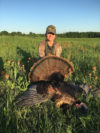
Courtney is an avid hunter from Louisiana. She has a passion all things outdoors and is an avid hunter. She is also a team member of Huntress View, an organization formed to help strengthen the ever growing community of women hunters.
What’s In Your Hunting Pack?
October 30th, 2016 by BTC Editor
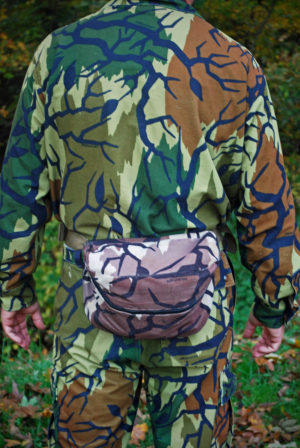
In two days, a couple buddies and I are heading to Pike County for a four-day bowhunting trip… No, not THAT Pike County, but it’s close. In fact, it’s right across the river from it. Both my pals are fairly novice bowhunters, and this is the first full season for one of them. Seeing as how I’ve been on several 10-day, DIY excursions to Colorado chasing my beloved wapiti, they’re leaning on me heavily to provide guidance as to what to bring. It’s actually not that uncommon a question from even veteran bowyers, as I see the “What’s In Your Bag?” query on the bowhunting forums quite often.
After well over a couple decades’ worth of bowhunting, with most of that time consisting of over 100 stand sits annually, I’ve definitely settled on a list of “must-haves” as well as items that have found their way into and out of my fanny pack. I’ll break down below exactly what I carry with me, and the use for each item.
- A small Ziploc bag (for weather protection) holding a good amount of toilet paper, plus hunting licenses. Also included in this bag are small zip ties for affixing the licenses to the deer’s back legs, a tube of chapstick (seems my lips are prone to drying out on windy days while on stand), and a handful of cherry cough drops (nothing worse than getting that tickle in your throat when you’re set up within 100 yards of that big buck’s bedding area!). I also put a nice lensatic compass in the bag, to keep the glass lens from getting scratched all up by the other items in my pack.
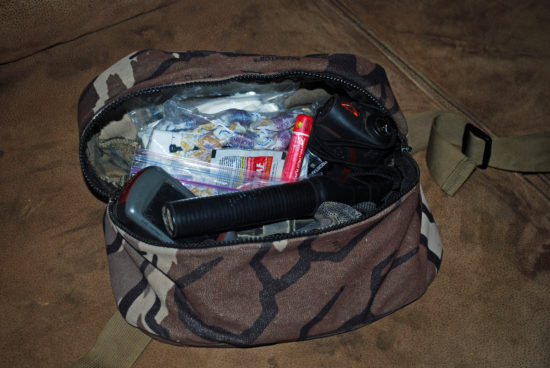
I’ll give you a tip about the toilet paper before moving on… I carry quite a bit of it with me, and obviously you probably realize one of its primary purposes. But I also lean on it just as heavily when tracking a deer at night by propane lantern. I tear off little half-squares and place every couple feet along the blood trail I’m unwinding… it’s remarkable how you can hold up your lantern and see those white squares trailing off into the blackness, and they’ll really help you get a “line” on the direction the deer’s traveling and where to look for next blood if you’re having difficulties. An added bonus is that when you’re done, you don’t have to go back and retrieve all of them — just let the next rain dissolve all of them for you.
- A mini-mag flashlight… the triple-battery version. I often end up in hairy places after dark I’ve never been through before, and I like to see what I’m trying to wade through – be it thorn bushes or a small creek. The version I like to carry just fits into my fanny pack from end to end, and utilizes three “AA” batteries.
- A headlamp. Sometimes, I’ll opt to turn my cap around backwards and slap on the headlamp. It’s especially helpful when I’m assembling my stand at the bottom of my tree after I get down in the pitch black, or when I’m gutting a deer after dark.
- A Leatherman multipurpose tool, the small kind. It contains a three-inch knife blade that I’ve used to gut over 50 deer, antelope and elk with. And on the off chance I need a pair of pliers, they’re included too.
- Limb saw… to trim shooting lanes with, and more importantly to cut off small branches on the tree I’m going up with my climber.
- My pull-up rope. I bought a commercial one with the plastic swiveling ends and hooks on it, cut those off and attached those to 30’ of parachute cord. Packs much tighter than the commercial one I bought.
- Rattle bag. I’ve got a very nice set of real rattling antlers that sound awesome, but they’re a pain to carry all the time. My rattle bag fits nicely inside my pack and is always there from the third week of October until December.
- Bleat can. I can’t attribute any single deer to coming in to the can call, but I’ll mix it into my rattling sequences any way; the hope is it’ll sound like the estrus doe that the two bucks are fighting over.
- True Talker grunt tube. This has accounted for more deer riding home with me than any other single piece of equipment.
- Ninety percent of the time, my shot opportunities are limited by heavy undergrowth and are 30 yards or less. Every once in a while though, I’ll sit a field edge where the rangefinder comes in handy.
- Diaphragm turkey call in a clear case. Archery deer tags come with two turkey tags included, and I won’t pass up an opportunity to call to a passing flock. I’ve got a wall-full of turkey fans above my desk that were all taken with my bow in deer season.
- Extra release. In case I leave my main one at the truck or it falls out of the tree for some reason.
- Four bow hooks. My bow goes on one above my left shoulder, and my fanny pack hangs from one around seat height on the same side of the tree. The other two are spares.
- A Kwikee Quiver caddy with my Octane quiver holder attached. I screw this into the left side of the tree, and affix my quiver upside-down so if I shoot and need to reload quickly, I simply reach behind me without looking and pull another arrow out.
- A hand-held Magellan GPS. This is a recently new addition to my pack, and one that I’ve come to value. I shoot a lot of deer just before dark as evening hunts comprise 98% of my trips afield (I’m just not a morning person). Usually, by the time I recover the deer and head back to my vehicle to get my game cart, it’s pitch black once I return to the scene of the crime. Having marked where my deer is laying via the GPS sure does make it a whole lot easier once everything looks completely different in the dark – and a whole lot easier to get out of the woods.
You could ask me any day of the year, and that’s what I’ll have in my fanny pack. It’s the main component of a system that I’ve fine-tuned for over 20 years of bowhunting, and it’s what enables me to grab my gear extremely quickly when I get home and be on my way to the woods in just a few minutes. I’m never scrambling around looking for this item or that; I simply know exactly where everything I need is.
Now, if it was only that easy to know where that big buck was…
Greg Staggs is the former back-page columnist for Inside Archery, and his writing regularly appears in such magazines as Outdoor Life and Petersen’s Bowhunting. Staggs loves introducing his two boys to all things outdoors, including fishing, trapping, canoeing and camping, and has been chasing turkeys and big game exclusively with archery equipment for over 20 years.
